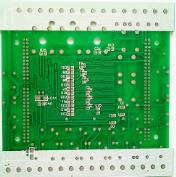Impedance matching
Impedance matching refers to a suitable collocation between signal source or transmission line and load. There are serial and parallel impedance matching methods according to the access mode. According to the signal source frequency impedance matching can be divided into low frequency and high-frequency PCB.

High-frequency signals generally use serial impedance matching
The resistance value of the serial resistance is 20-75 ω, which is proportional to the signal frequency and inversely proportional to the PCB wiring width. In embedded system, when the frequency of the signal is greater than 20M and the PCB wiring length is greater than 5cm, serial matching resistance should be added, such as clock signal, data signal and address bus signal in the system. The serial matching resistor serves two purposes:
Reduce high-frequency noise and edge overshoot. If the edge of a signal is very steep, it contains a lot of high frequency components, which will radiate interference. In addition, it is easy to produce overshoot. The series resistance forms an RC circuit with the distributed capacitance of the signal line and the load input capacitance, thus reducing the steepness of the signal edge.
Reduce high frequency reflections and self-excited oscillations. When the frequency of the signal is very high, the wavelength of the signal is very short. When the wavelength is so short that it is comparable to the length of the transmission line, the reflected signal superimposed on the original signal will change the shape of the original signal. If the characteristic impedance of the transmission line is not equal to the load impedance (that is, does not match), reflection will occur at the load end, resulting in self-excited oscillation. The low-frequency signal of PCB's internal wiring can be directly connected, generally do not need to add serial matching resistance.
Parallel impedance matching is also called "terminal impedance Matching"
Generally used in the input/output interface, mainly refers to the transmission cable impedance matching. For example, LVDS and RS422/485 use type 5 twisted-pair input matching resistance of 100~120 ω; The video signal uses a coaxial cable with matching resistance of 75 or 50 ω and a flat cable with matching resistance of 300 ω. The resistance value of the parallel matching resistance is related to the medium of the transmission cable, and has nothing to do with the length. Its main function is to prevent signal reflection and reduce self-excited oscillation.
It is worth mentioning that impedance matching can improve the EMI performance of the system. In addition to using series/parallel resistors to solve impedance matching, transformers CAN also be used to do impedance transformation.
Zero ohm resistance
Simple is used as jumper, if a certain line is not used, directly do not weld the resistance (does not affect the appearance).
When the matching circuit parameters are uncertain, it is replaced by zero ohms. During actual debugging, the parameters are determined and then replaced by components with specific values.
To measure the working current of a part of the circuit, you can remove the zero ohm resistance, connected to the ammeter, so that it is convenient to measure the current.
In wiring, if the cloth is really not past, you can also add a zero ohm resistance to play the role of bonding.
In high frequency signal networks, acts as inductor or capacitor (for impedance matching, zero ohm resistance also has impedance). When acting as inductor, the main purpose is to solve EMC problems.
Single point grounding, such as analog ground and digital ground single point docking common ground.
Configuration circuit can replace jumper and dip switch. Sometimes users will move the Settings, easy to cause misunderstanding, in order to reduce maintenance costs, the application of zero ohm resistance instead of jumper welding on the board.
For system debugging, for example, the system is divided into several modules, and the power supply and ground between modules are separated by zero ohm resistance. When the power supply or ground is short-circuiting during debugging, the zero ohm resistance can be removed to narrow the search range.
The above functions can also be replaced by "magnetic beads". Although the function of zero ohm resistance and magnetic bead are somewhat similar, but there are essential differences, the former has impedance characteristics, the latter has inductive reactance characteristics. Magnetic beads are generally used in power supply and earth network and have filtering effect.
If you want to do a good job, you must first sharpen the device, better understand impedance matching and zero ohm resistance, so that PCB design and manufacturing easier.